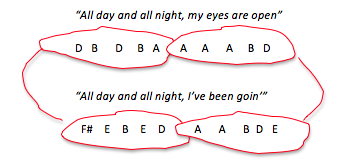 There’s more to a song hook than meets the ear… a lot more. “Hooks and Riffs: How They Grab Attention, Make Songs Memorable, and Build Your Fan Base” is a vital manual for any serious songwriter.
There’s more to a song hook than meets the ear… a lot more. “Hooks and Riffs: How They Grab Attention, Make Songs Memorable, and Build Your Fan Base” is a vital manual for any serious songwriter.
American indie rock group Moon Taxi’s 2015 single “All Day, All Night” is a good reminder that you can get considerable mileage by writing a melody that uses lots of repetition, where the changing chords underneath those melodic fragments are what keep things interesting.
The following diagram shows note names lined up with lyrics. You can easily hear and see the use of approximate repetition (the first circled pair), and then exact repetition (the second circled pair):

You could do a note-name analysis like this throughout the entire song, and you’ll notice that most of the melodic phrases are based on this very pentatonic-sounding melody. In a musical world where we value contrast (as I’ve been writing about recently), there’s not a lot of melodic contrast to be found.
You’d think that with this much repetition going on, the song would get boring very quickly. But you probably find, as I find, the song is very catchy, and the repetition doesn’t cross over into the realm of being monotonous or uninteresting. Why?
The main reason is that the chords keep changing underneath. Even though the verse limits the progression to two chords: D and G, the constant moving back and forth between those two chords lulls and entices us to keep listening.
The instrumental riff that directly follows verse 1 before the chorus happens is a short melodic idea that first gets harmonized with that same D and G chord pattern. The melody then repeats, all over a Bm chord, and later over Em.
I love and respect simplicity in music, sometimes more than complexity. Simplicity is hard to do, because you come very close to making things boring. But if you can get the balance right, simplicity will attract a lot of listeners.
If you’ve found a really great little melodic riff for your song but you worry that it’s repeating a bit too much, turn your attention to the chords that are supporting that melodic riff. If there’s a way to change chords as the idea keeps repeating, the repetition is less obvious.
And one other tip: I referred to the fact the melody used in “All Day All Night” is based on a pentatonic scale. You’ll find pentatonic melodies (using five notes, usually the first, second, third, fifth and sixth notes of a scale) are easy ones to get creative with, because they’ll harmonize well with so many chords.
 Written by Gary Ewer. Follow Gary on Twitter.
Written by Gary Ewer. Follow Gary on Twitter.
 Thousands of songwriters are using The Essential Secrets of Songwriting eBooks to straighten out their songwriting problems. Have you been spending years just reinforcing errors? Sort out your technique! Get today’s free deal!
Thousands of songwriters are using The Essential Secrets of Songwriting eBooks to straighten out their songwriting problems. Have you been spending years just reinforcing errors? Sort out your technique! Get today’s free deal!











Pingback: It Doesn’t Take Much | The Essential Secrets of Songwriting
Hey, long-time fan of your blog. I have a question. I’ve been trying to crack the shifting time signatures in PJ Harvey’s “Beautiful Feeling.” The verse seems to have two 3/4 measures followed by a 4/4 measure with a triplet at the end, but I can’t say for sure. Would you mind giving it a listen and letting me know your analysis? I’d truly appreciate it.
Hi MJ – Just giving this a listen, and it sounds quite complex. Though sometimes a complex time signature can simply be the result of a simple time signature with displaced accents.
So I haven’t figured it all out yet, but I can tell you that for the verse we’re hearing what sounds like it could be a bar of 4/4, with two groups of 8th-note triplets, then triplets but grouped 2+4.
The next bar is the same, but instead of 2+4 at the end, it’s 2+5.
I’d need to give it more listens to figure out more. Also, as I say, some complexities are attributable to accents, not necessarily time signature changes. I might be able to find the printed music online, but that would be cheating, wouldn’t it? 😉
-Gary
Thanks Gary – I definitely hear what you’re hearing. Haven’t had much luck finding sheet music for that album, which is a shame because she’s a brilliant songwriter, but I appreciate your insight!